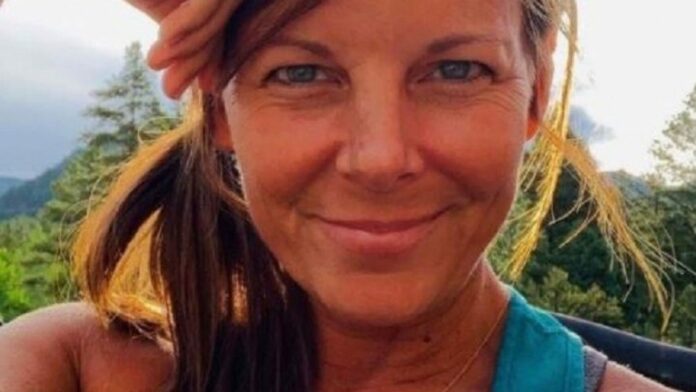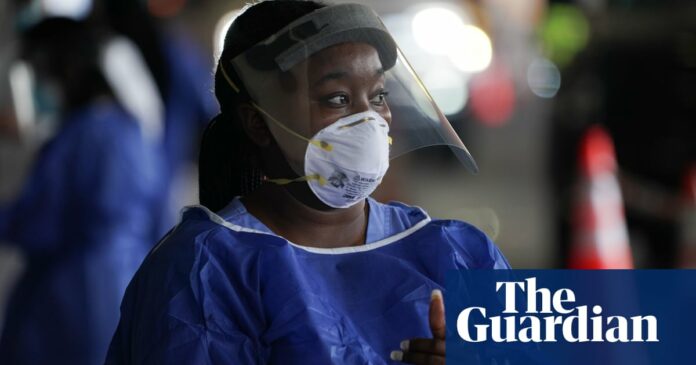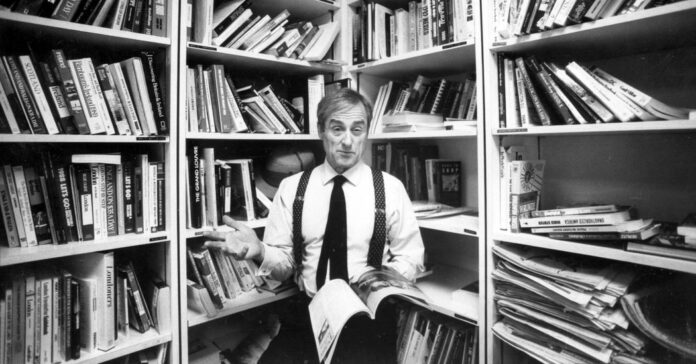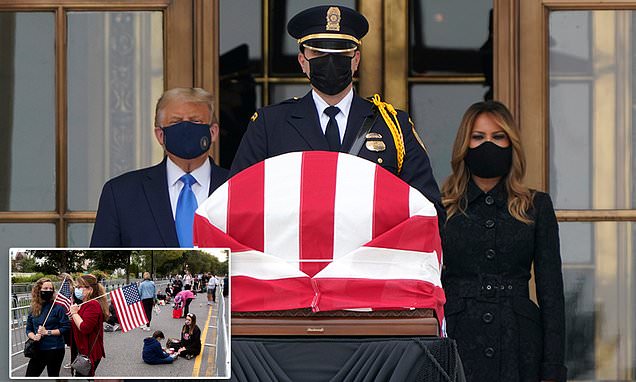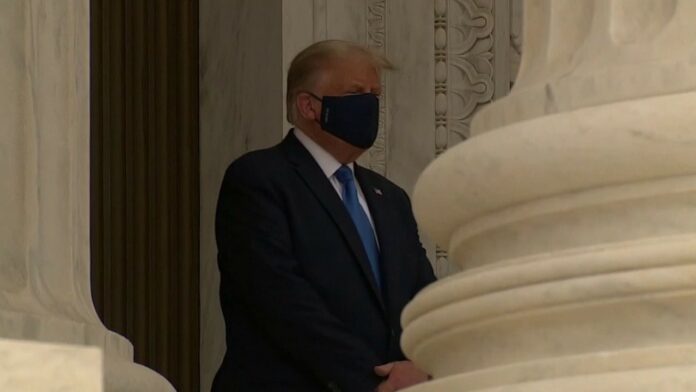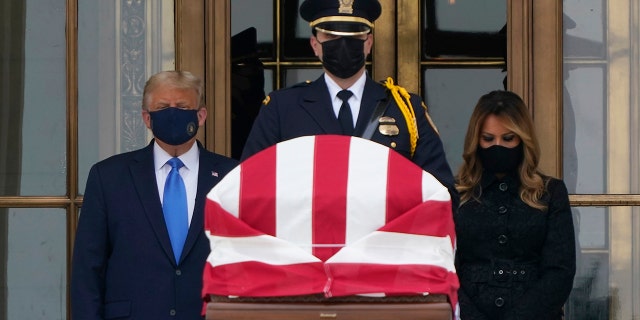Donald and Melania Trump were booed by crowds at the Supreme Court on Thursday when they paid their respects to the late Justice Ruth Bader Ginsburg.
‘Honor her wish,’ the crowd yelled as the first couple stood at the top of the steps at Ginsburg’s flag-draped coffin, their heads bowed and faces covered by masks.
‘Vote him out,’ was also heard being yelled by people standing along the side of the Supreme Court building.
It’s rare for President Trump to hear any criticism or booing in his public appearances. His campaign rallies and events are typically filled with cheering supporters who offer constant applause and adoration. The rare protester is quickly escorted out.
Thousands of mourners have lined up at the Supreme Court to pay tribute to the late justice, who became a cultural icon and feminist hero. Many of them supported Ginsburg’s liberal philosophy, putting them in direct opposition to the president.
‘Honor her wish,’ was in reference to Ginsburg’s dying request that the winner of the November presidential election appoint her successor.
But Trump has vowed to move forward in the confirmation process and will name his replacement on Saturday at the White House. He is expected to name a conservative to fill the liberal judge’s place on the bench.
The first couple arrived for their short visit at the back of the Supreme Court building and walked through it and out its front door to view Ginsburg’s coffin. That could have been for security reasons given the heavy crowds and lines of people in front of the court.
The Trumps spent 11 minutes at the court before returning to the White House.
Upon his return to the executive mansion, President Trump was spotted on the colonnade outside of the Oval Office, speaking with his Chief of Staff Mark Meadows, White House Counsel Pat Cipollone, and National Security Adviser Robert O’Brien – all of whom accompanied him to the Supreme Court.
President Donald Trump and first lady Melania Trump pay respects as Justice Ruth Bader Ginsburg on Thursday
President Trump at the casket of Ruth Bader Ginsburg
‘Honor her wish,’ the crowd yelled at President Trump in reference to Ruth Bader Ginsburg’s dying request that the winner of the November election name her replacement
First lady Melania Trump bows her head at Ginsburg’s coffin
Mourners line up before Ginsburg’s casket; thousands have come to the Supreme Court to pay tribute to the late justice
National security adviser Robert O’Brien, left, and White House chief of staff Mark Meadows, right, pays their respects to Ginsburg
Upon his return to the White House, President Trump stood outside the Oval Office, speaking with his Chief of Staff Mark Meadows, White House Counsel Pat Cipollone, and National Security Adviser Robert O’Brien – all of whom accompanied him to the Supreme Court
Trump has cast doubt on Ginsburg’s wish, alleging it was actually written by a Democrat.
He accused his political foes – Senate Democratic Leader Chuck Schumer, Speaker Nancy Pelosi or House Intelligence Chairman Adam Schiff – as being behind the justice’s last request – an allegation that has no proof nor did Trump offer any.
‘I don’t know that she said that, or was that written out by Adam Schiff, Schumer and Pelosi,’ Trump said during an interview on ‘Fox & Friends’ on Monday.
‘I would be more inclined to the second, it sounds so beautiful. But that sounds like a Schumer deal or maybe a Pelosi or shifty Schiff. So that that came out of the wind. Let’s see. I mean, maybe she did and maybe she didn’t,’ he added.
Ginsburg dedicated a message to her granddaughter Clara Spera in her dying days.
‘My most fervent wish is that I I will not be replaced until a new president is installed,’ she said.
While Ginsburg is honored in the court where she made history, the political battle to replace her is taking place across the street in the U.S. Capitol building.
Democrats have vowed to do what they can to hold off President Trump’s nomination, arguing the winner of the November election should make the selection. They point both to Ginsburg’s dying wish and to 2016 – the year Republican Senate Leader Mitch McConnell held off the confirmation process on then President Barack Obama’s Supreme Court nominee, stating he would wait and see which party won the election.
But Democrats’ odds are slim given Republicans have lined up behind the president and are preparing to move forward with confirmation hearings. They argue the situation is different compared to 2016 since one party controls both the Senate and White House this year.
Thursday, meanwhile, marks the second day of public viewing of Ginsburg’s remains.
Her flag-draped casket arrived at the Supreme Court Wednesday morning, where she was honored with a small memorial ceremony before her coffin was placed atop the front steps for two days of public viewing.
Former President Bill Clinton, who appointed Ginsburg to the high court in 1993, visited her on Wednesday along with Hillary Clinton. Vice President Mike Pence and his wife Karen paid their respects on Wednesday evening. Several members of Congress also came by the Supreme Court.
‘Ruth is gone and we grieve,’ Chief Justice John Roberts said in his eulogy during Wednesday’s memorial service. ‘Of course, she will live on in what she did to improve the law and the lives of all of us.’
Ahead of Ginsburg’s arrival, 120 of her former law clerks lined up in rows down the Supreme Court’s stairs, dressed in black and wearing black face coverings in an image of solemn mourning.
The clerks formed an honor guard as her remains arrived at the building where she served, standing in silence as her coffin was carried up the steps and into the court.
Roberts, in his moving tribute, described Ginsburg’s affect on American law and her inspiration to women, calling her a ‘rock star.’
‘It has been said that Ruth wanted to be an opera virtuoso, but became a rock star instead. But she chose the law, subjected to discrimination in law school and the job market because she was a woman, Ruth would grow to become the leading advocate fighting such discrimination in court. She found her stage right behind me in our courtroom,’ he said.
‘There she won famous victories that helped move our nation closer to equal justice under law, to the extent that women are now a majority in law schools, not simply a handful. Later she became a star on the bench where she sat for 27 years. Dissenting opinions will steer the court for decades. They are written with the unaffected case of precision,’ he noted.
‘Her voice in court and in our conference room was soft, but when she spoke, people listened. Among the words that best describe Ruth, tough, brave, a fighter, a winner, but also thoughtful, careful, compassionate, honest. When it came to opera, insightful, passionate. When it came to sports, clueless,’ he added as people chuckled.
He also noted Ginsburg had friends across the political aisle, highlight at trip she took to India with Justice Antonin Scalia, a conservative member of the court who died in 2016, and recalled them riding an elephant together.
‘In the photograph, she’s riding with a dear friend, a friend with totally divergent views,’ Roberts said. ‘There’s no indication in the photo that either was poised to push the other off.’
Mourners pass by the Supreme Court stairs where Ruth Bader Ginsburg’s casket lies in repose; her coffin will remain on the front steps through Thursday
Vice President Mike Pence and second lady Karen Pence paid their respects to Ruth Bader Ginsburg when they visited her casket on Wednesday evening
Vice President Mike Pence and Karen Pence joined a long list of lawmakers who stopped by the Supreme Court to pay their respects
U.S. Supreme Court Police salute the casket of the late Supreme Court Associate Justice Ruth Bader Ginsburg as they place her remains on the building’s front stairs for the public viewing
Bill and Hillary Clinton pay their respects to the late Supreme Court Justice Ruth Bader Ginsburg
Former President Bill Clinton, who appointed Ruth Bader Ginsburg to the Supreme Court, rests his hand on his heart as he pays his respects at the Supreme Court
Chief Justice John Roberts gave the eulogy for Ginsburg as her family and fellow justices honored her legacy
Ruth Bader Ginsburg was honored by her friends, family, former law clerks and fellow justices in a ceremony in the Supreme Court’s great hall on Wednesday morning
Chief Justice John Roberts called Ginsburg a ‘rock star’ in his eulogy, where he paid tribute to her status as a cultural icon and hero to women
Ruth Bader Ginsburg’s flag draped coffin arrives at the Supreme Court to lie in repose for two days after she died from complications from colon cancer on Friday
Her former law clerks – 120 in total – await the casket of Justice Ruth Bader Ginsburg to arrive at the Supreme Court
A mourner pays their respects to Ginsburg
A child in a Supergirl costume pays respects to Justice Ruth Bader Ginsburg
: Frankie Frezzell (R), 2, and Lucille Wilson (L), 3, wait in line dressed in tribute Ginsburg with her signature white lace collar
Mourners, many of whom brought their children, wait in line to pay their respects to Ginsburg
Many people brought signs and flowers to leave for the late Supreme Court justice
Family members of Justice Ruth Bader – including Jane C. Ginsburg – wait her casket to arrive at the court
Ginsburg’s casket arrives in the Great Hall at the Supreme Court, where a small group of family and friends honored her legacy
Ruth Bader Ginsburg’s casket is carried into the Supreme Court building as her former law clerks form an honor guard
Thousands of mourners are expected to pay tribute to Ginsburg and the lines went down the street by the Supreme Court with the Capitol Dome in the distance
Mourners pay their respects to the late justice, who was hailed as a feminist icon
A woman pays tribute to Ginsburg as the public filed by to pay their respects to the late justice
People line up in socially distanced rows to wait their turn to pay their respects to Ruth Bader Ginsburg
A 2016 portrait of Ginsburg by artist Constance P. Beaty was on display during the brief ceremony.
‘Today we stand in mourning of the American hero, Justice Ruth Bader Ginsburg,’ the Rabbi Lauren Holtzbatt said.
Holtzbatt paid tribute to Ginsburg’s status as an American feminist icon.
‘To be born into the world that does not see you, that does not believe in your potential, that does not give you a path for opportunity, or a clear path for education and despite this, to be able to see beyond the world you are in, to imagine that something can be different. That is the job of a prophet. And it is the rare prophet who not only imagines a new world, but also makes that new world a reality in her lifetime. This was the brilliance and vision of Justice Ruth Bader Ginsburg,’ she said.
She touted Ginsburg as a ‘role model to women and girls of all ages, who now know that no office is out of reach for their dreams: whether that is to serve in the highest court of our land or closer to home.’
The entrance to the courtroom, along with Ginsburg’s chair and place on the bench next to Roberts, have been draped in black, a longstanding court custom.
Her coffin rested on a Lincoln catafalque, on loan from Congress, that once held President Abraham Lincoln’s remains.
Ginsburg also will become the first woman to lie in state in the U.S. Capitol when her coffin lies in Statutory Hall on Friday. She will be buried in Arlington National Cemetery next week, where her husband Marty Ginsburg lies in rest.
Since her death on Friday from colon cancer, thousands laid flowers, notes, candles and stuffed animals on the court’s step to pay homage to a woman who found fame late in life, known as the ‘Notorious RBG’ for her fiery dissents.
Court workers removed them to make way for her casket’s arrival on Wednesday.
Born in Brooklyn, she was one of the few women in her class at Harvard Law. Transferring to Columbia Law when her husband took a job in New York, she graduated first in her class. She argued before the Supreme Court on gender and equity issues before then-President Bill Clinton appointed her to the bench in 1993.
She became vocal force with her dissents and a cultural icon with her white lace collar on her black robe and her over sized glasses.
A 2016 portrait of Ginsburg by artist Constance P. Beaty was on display during the brief ceremony
The Supreme Court justices and their spouses sit in front of the flag-draped casket of Justice Ruth Bader Ginsburg during Wednesday’s ceremony
Supreme Court Justice Brett Kavanaugh and his wife Ashley at Ginsburg’s memorial ceremony
Justice Sonia Sotomayor stands during Ginsburg’s memorial ceremony
Flowers and other memorabilia have been left in front of the Supreme Court since Ginsburg died on Friday
the lines of mourners stretched from the Supreme Court building across the street to the US Capitol
Ruth Bader Ginsburg’s coffin will lie on the front steps of the Supreme Court building on Wednesday and Thursday for the public to pay tribute to the late justice
Supreme Court police begin to bring the body of Justice Ruth Bader Ginsburg up the steps of the Supreme Court. Lining the steps of the court are her former clerks, who acted as honorary pallbearers ahead of the ceremony
The justice’s former law clerks, who will serve as honorary pallbearers, lined up as Ginsburg’s casket arrived
Law clerks dressed in black with black face masks watch as Ginsburg’s casket arrives at the Supreme Court building
Members of a Supreme Court Police honor guard position the flag-draped casket of Justice Ruth Bader Ginsburg under the Portico at the top of the front steps of the Supreme Court building
Supreme Court Justice Clarence Thomas and his wife Virginia Thomas watch as Ginsburg’s casket arrives
Justice Stephen Breyer and his wife Joanna at Ginsburg’s memorial service
Justice Neil Gorsuch (left) and Justice Stephen Breyer (right) during Ginsburg’s memorial service
Senate Minority Leader Chuck Schumer (L) and Senator Bernie Sanders pay their respects to Ginsburg
Republican Senator Susan Collins of Maine stops by the Supreme Court to pay her respects
Many mourners wiped away tears as they paid their respects to Ginsburg
Members of CASA, an advocacy organization for Latino and immigrant people, hold up white roses in honor of Ginsburg
A sign thanking Ginsburg for her dedication to equal rights
The portrait of Ruth Bader Ginsburg surrounded by flowers stood in the Great Hall of the Supreme Court
Lucille Wilson, 3, wears a RBG collar while waiting in line to view the casket of Ruth Bader Ginsburg
Two women arrive to pay their respects to Ginsburg, the women’s rights champion, leader of the court’s liberal bloc and feminist icon who died last week aged 87
Thousands are expected to gather by the Supreme Court over the next two days
Bill and Hillary Clinton depart the Supreme Court after paying their respects to the late Justice Ruth Bader Ginsburg
Ruth Bader Ginsburg died on Friday at the age of 87 due to complications from an ongoing battle with pancreatic cancer
Judge Amy Coney Barrett is reported to be at the top of his short list with Judge Barbara Lagoa in second. Trump has vowed to pick a woman to replace Ginsburg, a feminist icon and hero to liberals.
Whomever he picks, the president is expected to shift the court to the right with his decision.
Saturday’s announcement will come shortly before the president leaves for Pennsylvania, where he will hold a rally in Middletown in the crucial 2020 battleground state.
Given the close proximity between the election and the nomination process, the Supreme Court is highly likely to become a political hot potato in the presidential race.
President Trump said Wednesday the court needs its full complement of nine justices because they may have to decide the winner of the 2020 presidential contest.
Trump repeated his many complaints and concerns about mail-in ballots – at least 80 million Americans are expected to use them instead of waiting in line on Election Day because of the coronavirus – and said the issue will likely end up in the high court.
‘I think it’s better if you go before the election because I think the scam the Democrats are pulling, this scam will be before the United States Supreme Court,’ Trump said at the White House.
He said a tie situation of 4-to-4 justices would not ideal although if that should be the scenario then the lower court ruling would stand.
‘I think having a 4-4 situation is not a good situation,’ Trump said.
‘Just in case it would be more political than it should be I think it’s very important to have a 9th judge,’ he said.
But Republican Senate Leader Mitch McConnell on Tuesday would not promise a vote on the nomination before the election.
McConnell said he would wait for the person to come out of Senate Judiciary Committee hearings and then set the date for the vote on the Senate floor.
‘When the nomination comes out of committee, then I’ll decide when and how to proceed,’ he said after the Senate Republicans’ lunch on Capitol Hill Tuesday.
He would not address if that vote would be before or after November 3, when voters decide who will be the next president of the United States.
President Trump has pushed for a vote on his nominee before the general election but McConnell could be more peckish on the timing to help out his senators in tight re-election contests who would prefer to deal with the issue after the voters go to the polls.
Timing in the Senate is also tough. There would be less than 40 days before the election to complete the process when most nominations take at least 70 days. Traditionally a nominee holds meetings with senators, has a confirmation hearing that could take two or three days, has to be voted out of committee and then has the final vote on the Senate floor.
President Trump poses with the Supreme Court justices in June 2017: From left are, Associate Justices Elena Kagan, Samuel A. Alito, Jr., Ruth Bader Ginsburg, and Anthony Kennedy, Chief Justice John Roberts, Jr., the president, Associate Justices Neil Gorsuch, Clarence Thomas, Stephen G. Breyer, and Sonia Sotomayor
Who is Amy Coney Barrett?
On Saturday afternoon, Trump named Amy Coney Barrett, 48, of the Chicago-based 7th Circuit and Barbara Lagoa, 52, of the Atlanta-based 11th Circuit as possible nominees.
Emerging as the favorite is Barrett, 48, a mother of seven children, including two adopted from Haiti and one with special needs.
Her involvement in a cult-like Catholic group where members are assigned a ‘handmaiden’ has caused concern in Barret’s nomination to other courts and is set to come under fierce review again if she is Trump’s pick.
The group was the one which helped inspire ‘The Handmaids Tale’, book’s author Margaret Atwood has said.
Barrett emerges now as a front runner after she was already shortlisted for the nomination in 2018 which eventually went to Brett Kavanaugh.
Trump called the federal appellate court judge ‘very highly respected’ when questioned about her Saturday.
Born in New Orleans in 1972, she was the first and only woman to occupy an Indiana seat on the Seventh Circuit Court of Appeals.
Married to Jesse M. Barrett, a partner at SouthBank Legal in South Bend and former Assistant United States Attorney for the Northern District of Indiana, the couple have five biological and two adopted children.
Their youngest biological child has Down Syndrome.
Friends say she is a devoted mother – and say with just an hour to go until she was voted into the 7th District Court of Appeals by the U.S. Senate in 2017, Barrett was outside trick-or-treating with her kids.
Barrett’s strong Christian ideology makes her a favorite of the right but her involvement in a religious group sometimes branded as a ‘cult’ is set to be harshly criticized.
In 2017, her affiliation to the small, tightly knit Christian group called People of Praise caused concern while she was a nominee for a seat on the United States Court of Appeals for the Seventh Circuit.
The New York Times reported that the practices of the group would surprise even other Catholics with members of the group swearing a lifelong oath of loyalty, called a covenant, to one another.
They are also assigned and held accountable to a personal adviser, known until recently as a ‘head’ for men and a ‘handmaid’ for women and believe in prophecy, speaking in tongues and divine healings.
Members are also encouraged to confess personal sins, financial information and other sensitive disclosures to these advisors.
Advisors are allowed to report these admissions to group leadership if necessary, according to an account of one former member.
The organization itself says that the term ‘handmaid’ was a reference to Jesus’s mother Mary’s description of herself as a ‘handmaid of the Lord.’
They said they recently stopped using the term due to cultural shifts and now use the name ‘women leaders.’
The group deems that husbands are the heads of their wives and should take authority over the family while ‘the heads and handmaids give direction on important decisions, including whom to date or marry, where to live, whether to take a job or buy a home, and how to raise children,’ the Times reported.
Unmarried members are placed living with married couples members often look to buy or rent homes near other members.
Founded in 1971, People of Praise was part of the era’s ‘great emergence of lay ministries and lay movements in the Catholic Church,’ founder Bishop Peter Smith told the Catholic News Agency.
Beginning with just 29 members, it now has an estimated 2,000.
According to CNA, some former members of the People of Praise allege that leaders exerted undue influence over family decision-making, or pressured the children of members to commit to the group.
At least 10 members of Barrett’s family, not including their children, also belong to the group.
Barrett’s father, Mike Coney, serves on the People of Praise’s powerful 11-member board of governors, described as the group’s ‘highest authority.’
Her mother Linda served as a handmaiden.
The group’s ultra-conservative religious tenets helped spur author Margaret Atwood to publish The Handmaid’s Tale, a story about a religious takeover of the U.S. government, according to a 1986 interview with the writer.
The book has since been made into a hit TV series.
According to legal experts, loyalty oaths such at the one Barrett would have taken to People of Praise could raise legitimate questions about a judicial nominee’s independence and impartiality.
‘These groups can become so absorbing that it’s difficult for a person to retain individual judgment,’ said Sarah Barringer Gordon, a professor of constitutional law and history at the University of Pennsylvania.
‘I don’t think it’s discriminatory or hostile to religion to want to learn more’ about her relationship with the group.
‘We don’t try to control people,’ said Craig S. Lent. ‘And there’s never any guarantee that the leader is always right. You have to discern and act in the Lord.
‘If and when members hold political offices, or judicial offices, or administrative offices, we would certainly not tell them how to discharge their responsibilities.’
During her professional career, Barrett spent two decades as a law professor at the University of Notre Dame, from which she holds her bachelor’s and law degrees.
She was named ‘Distinguished Professor of the Year’ three separate years, a title decided by students.
A former clerk for late Supreme Court Justice Antonin Scalia, she was nominated by Trump to serve on the 7th U.S. Circuit Court of Appeals in 2017 and confirmed in a 55-43 vote by the Senate later that year.
At the time, three Democratic senators supported her nomination: Joe Donnelly (Ind.), who subsequently lost his 2018 reelection bid, Tim Kaine (Va.) and Joe Manchin (W.Va.), according to the Hill.
She was backed by every GOP senator at the time, but she did not disclose her relationship with People of Praise which led to later criticism of her appointment.
Barret is well-regarded by the religious right because of this devout faith.
Yet these beliefs are certain to cause problems with her conformation and stand in opposition to the beliefs of Ginsburg, who she would be replacing.
Axios reported in 2019 that Trump told aides he was ‘saving’ Barrett to replace Ginsburg.
Her deep Catholic faith was cited by Democrats as a large disadvantage during her 2017 confirmation hearing for a seat on the U.S. Court of Appeals for the 7th Circuit.
‘If you’re asking whether I take my faith seriously and I’m a faithful Catholic, I am,’ Barrett responded during that hearing, ‘although I would stress that my personal church affiliation or my religious belief would not bear in the discharge of my duties as a judge.’
Republicans now believe that she performed well in her defense during this hearing, leaving her potentially capable of doing the same if facing the Senate Judiciary Committee.
She is a former member of the Notre Dame’s ‘Faculty for Life’ and in 2015 signed a letter to the Catholic Church affirming the ‘teachings of the Church as truth.’
Among those teachings were the ‘value of human life from conception to natural death’ and marriage-family values ‘founded on the indissoluble commitment of a man and a woman’.
She has previously written that Supreme Court precedents are not sacrosanct. Liberals have taken these comments as a threat to the 1973 Roe v. Wade decision legalizing abortion nationwide.
Barrett wrote that she agrees ‘with those who say that a justice’s duty is to the Constitution and that it is thus more legitimate for her to enforce her best understanding of the Constitution rather than a precedent she thinks clearly in conflict with it’.
Among the other statements that have cause concern for liberal are her declaration that ObamaCare’s birth control mandate is ‘grave violation of religious freedom.’
LGBTQ organizations also voiced their concern about her when she was first named on the shortlist.
She has also sided with Trump on immigration.
In a case from June 2020, IndyStar reports that she was the sole voice on a three-judge panel that supported allowing federal enforcement of Trump’s public charge immigration law in Illinois,
The law would have prevented immigrants from getting legal residency in the United States if they rely on public benefits like food stamps or housing vouchers.



